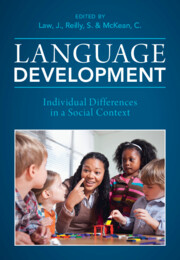Book contents
- Language Development
- Language Development
- Copyright page
- Contents
- Figures
- Tables
- Contributors
- A Tribute to Our Friend, Colleague and Fellow Editor, Professor James Law
- Introduction
- 1 Language Development
- 2 Social Contexts and Language Development
- Part One Factors Influencing Language Development
- Part Two Continuity and Change
- Part Three Impact, Intervention and Equity
- Index
- References
1 - Language Development
Individual Differences in a Social Context
from Introduction
Published online by Cambridge University Press: 11 August 2022
- Language Development
- Language Development
- Copyright page
- Contents
- Figures
- Tables
- Contributors
- A Tribute to Our Friend, Colleague and Fellow Editor, Professor James Law
- Introduction
- 1 Language Development
- 2 Social Contexts and Language Development
- Part One Factors Influencing Language Development
- Part Two Continuity and Change
- Part Three Impact, Intervention and Equity
- Index
- References
Summary
Language development in young children is clearly associated with the context in which children grow up. Of course, it has a strong biological developmental element but it is the interaction between the social and the developmental that is the focus of this book. Children’s language skills vary considerably at any one point in their development but especially over time. This chapter introduces the reader to some of the key concepts in the book and, in particular, focuses on how this interaction works for children with skills at the lower end of the language distribution, namely children with developmental language disorders, and how the patterns of these skills change over time. Key to understanding these issues is the need to follow large representative national samples of children for extended periods of time and assessing their performance at regular intervals, a feature of many chapters in the book. The book is targeted at academic, professional and an ‘informed’ public audience. The academic audience will include linguists, psychologists, speech and language pathologists, public health professionals and paediatricians and their equivalent in different countries. But it will also be important for health, education and public policy professionals.
Keywords
Information
- Type
- Chapter
- Information
- Language DevelopmentIndividual Differences in a Social Context, pp. 3 - 22Publisher: Cambridge University PressPrint publication year: 2022
References
Accessibility standard: Unknown
Why this information is here
This section outlines the accessibility features of this content - including support for screen readers, full keyboard navigation and high-contrast display options. This may not be relevant for you.Accessibility Information
- 1
- Cited by
